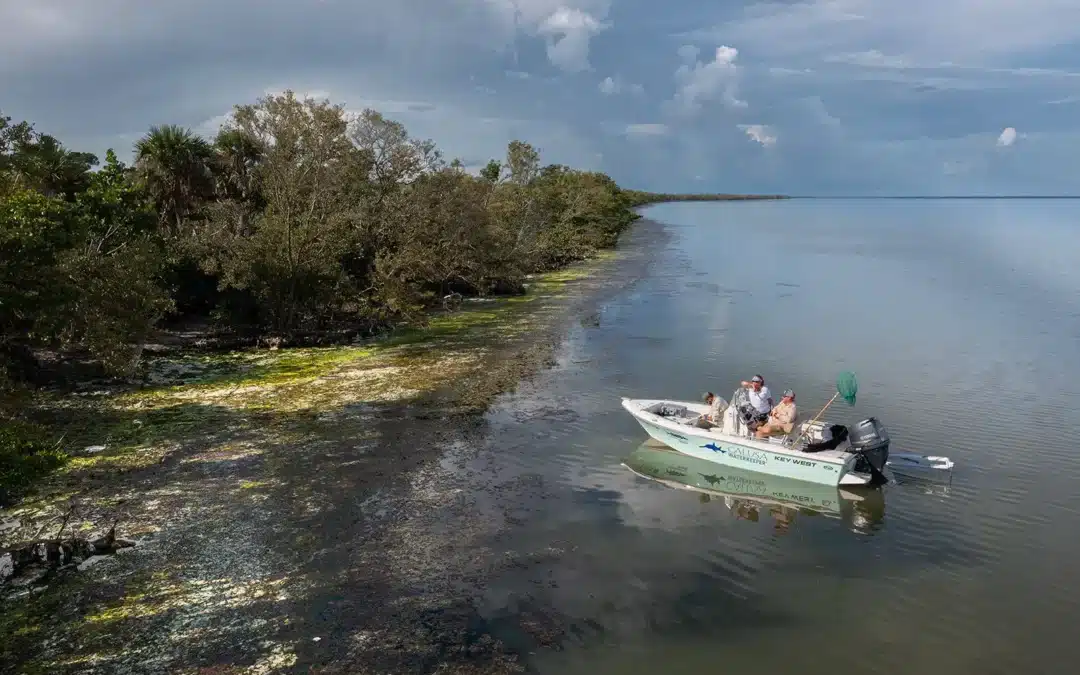Our nearshore waters are crying for help, but are we listening?
In Lee County, many are familiar with the impact that Lake Okeechobee discharges and basin runoff have on the Caloosahatchee Estuary, especially the vivid colors and massive environmental and health concerns associated with toxic blue-green algae outbreaks. However, toxic blue-green algae and red tide are not the only damaging forms of algae outbreaks that continue to plague our coastline, negatively impacting our environment, economy and quality of life. A prime example is what is happening right now to the ecosystem within Matlacha Aquatic Preserve and Charlotte Harbor, where a lesser-known, but extremely concerning bloom of Dapis algae is occurring.
If you’ve never heard of Dapis algae, you’re not alone. It does not seem to get much air time, and until Calusa Waterkeeper, Codty Pierce, took members of our Policy Team out on the water, this was not an issue on our radar. Our staff learned many things during that hot (but extremely informative) June day, and one thing that struck us was that while Dapis algae is certainly having disastrous effects, it seems to be happening quietly, without much publicity or fanfare.
Dapis algae, a type of blue-green algae, starts out growing attached to something on the sea floor such as seagrass. It then grows upwards, breaks off and floats to the surface. On the surface, it looks and feels like dark, slimy strands of hair and smells like rotten eggs. When you see it on the surface, it is typically not growing, but decomposing. Wind pushes the algae towards shore where it creates large mats. These mats block sunlight from reaching the water thus preventing sea grasses and other plants from growing, essentially disrupting the food web.
As the algae decomposes it is also depleting dissolved oxygen in the water which leads to fish kills and a loss of habitat for fish and shellfish. In humans, it causes skin irritations, eye infections, and breathing problems to some of the population that recreate and reside along our coasts. This monoculture overwhelms the natural checks and balances of the ecosystem. This issue began after Hurricane Irma passed through in September 2017 and saturated our region with an immense amount of precipitation. Since then, this algae has steadily spread to the current prevalence we see today from Sword Point on the northern mouth of the Caloosahatchee all the way to the Alligator Creek region of Charlotte County in Northwest Charlotte Harbor.
Restoration Is An Important Part of the Solution

Meaningful Water Policy Improvements Are Necessary
While sheet flow restoration of key areas in the watershed is critical, Dapis algae is flourishing because of poor water quality, caused by many different factors, including high levels of Fecal indicator bacteria present throughout our watershed, nitrate-laden runoff stemming from urban development and agriculture, high concentrations of ammonia from decaying organics such as algae decomposition and fish kills.
These problems can be mitigated through the use of an effective and comprehensive basin management action plan (BMAP). A BMAP is a framework developed by the Florida Department of Environmental Protection for water quality restoration to reduce pollutant loading through current and future projects and strategies.
These plans include strategies such as permit limits on wastewater facilities, urban and agricultural best management practices, and conservation programs designed to achieve pollutant reductions established by a total maximum daily load (TMDL). Unfortunately, to date, these plans have been ineffective in addressing Florida’s water quality problems. Therefore, meaningful BMAP updates, enforcement of existing regulations, and better stewardship by our communities are necessary. Our actions often inadvertently contribute to nutrient loading, such as fertilizer runoff and stormwater discharge. The more educated and aware our communities are regarding how to prevent pollution means that we all can be part of the solution.
As residents of Southwest Florida, we are but caretakers of this phenomenal tropical paradise for the chapter in the timeline at hand.
Read Story on Conservancy of Southwest Florida

























